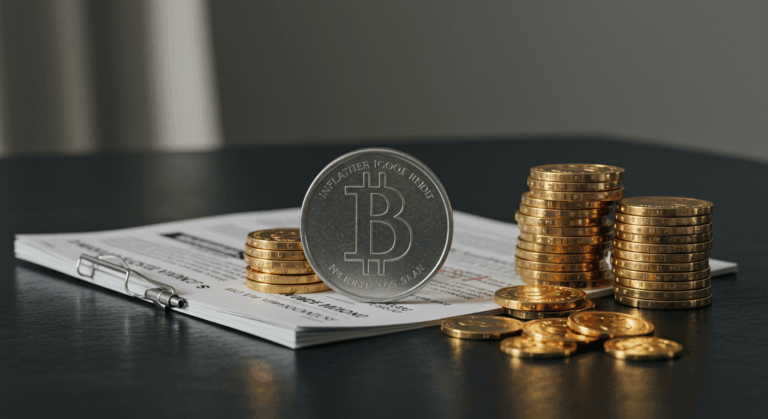Stagflation: When the Economy Stagnates and Prices Rise (The Worst-Case Scenario)
Imagine your grocery bill is soaring, your savings are earning less in real terms, and the news is filled with talk of economic slowdown and job losses. This is not a typical recession or just a period of high inflation. It is a combination of the two, a dreaded economic phenomenon known as stagflation. This term, a blend of stagnation and inflation, describes one of the most challenging environments for consumers, investors, and policymakers alike. In this article, we will demystify what stagflation is, explore its causes, and, most importantly, provide you with practical strategies to navigate this complex economic landscape and protect your financial well-being.
What Exactly is Stagflation? A Toxic Cocktail
Stagflation is a unique and damaging economic condition characterized by a toxic trio of problems happening simultaneously. It represents a direct assault on both your income and your savings, making it feel like you are being squeezed from all sides.
At its core, it is defined by three concurrent negative trends:
- Stagnant Economic Growth: The economy stops growing or grows very slowly. This means businesses are not expanding, production is flat, and overall economic output, measured by Gross Domestic Product (GDP), is weak.
- High Inflation: At the same time, the general level of prices for goods and services rises sharply and persistently. Your money buys less and less every month, relentlessly eroding your purchasing power.
- High Unemployment: With a stagnant economy, companies stop hiring and may even lay off workers to cut costs. This leads to a rise in the unemployment rate, making it harder for people to find or keep jobs.
This combination is particularly painful because the usual remedies for each problem often make the other worse. For example, to combat a recession (stagnation), central banks might lower interest rates to encourage borrowing and spending. However, during stagflation, this could fuel even higher inflation. Conversely, raising interest rates to fight inflation can further slow down the economy and increase unemployment. It is an economic Catch-22 that leaves policymakers with few good options.

The Causes of Stagflation: A Perfect Storm
Stagflation does not just appear out of nowhere. It is typically triggered by a convergence of factors that create a perfect economic storm. Understanding these causes helps to see why it is so difficult to resolve. The most common drivers include:
- Supply Shocks: This is a primary culprit. A supply shock is a sudden, unexpected event that drastically reduces the supply of a key commodity or service, which in turn drives up prices across the board. The classic example is the oil crisis of the 1970s, when an embargo by oil-producing nations caused oil prices to skyrocket. This increased transportation and production costs for almost every industry, leading to widespread inflation while simultaneously choking off economic growth.
- Poor Economic Policies: Governments and central banks can inadvertently create the conditions for stagflation. For instance, a central bank might pursue an overly expansionary monetary policy, essentially printing too much money, in an attempt to lower unemployment. This can lead to runaway inflation. If this happens when the economy’s productive capacity is already limited, you get rising prices without a corresponding increase in growth.
- Structural Rigidities: Sometimes, deep-seated issues within an economy can contribute to stagflation. These could include excessive regulation that stifles business innovation, labor market inflexibility that keeps wages high even as demand falls, or a lack of investment in critical infrastructure. These rigidities prevent the economy from adapting efficiently to shocks, leading to both stagnation and price pressures.
How Does Stagflation Affect Your Wallet?
The macroeconomic theory is important, but what does stagflation mean for your personal finances? The impact is direct and can be severe, affecting nearly every aspect of your financial life.
Your cost of living increases significantly due to inflation. Everything from fuel and food to housing and healthcare becomes more expensive. At the same time, your wages may not keep pace, meaning your real income—what you can actually buy with your money—declines. Your savings also lose value. If the inflation rate is 7% and your savings account yields 1%, you are losing 6% of your purchasing power every year just by leaving your money in the bank.
Job security becomes a major concern. With economic stagnation, companies face squeezed profit margins and reduced consumer demand. This makes them hesitant to hire and more likely to implement layoffs to cut costs. Finding a new job becomes more difficult as the unemployment rate rises. For investors, stagflation is a nightmare. Both stocks and bonds, the traditional pillars of a portfolio, can perform poorly. Corporate earnings suffer in a stagnant economy, hurting stock prices, while rising interest rates (a tool to fight inflation) can cause bond prices to fall.
Strategies to Protect Your Finances During Stagflation
While you cannot control the national economy, you can take proactive steps to fortify your financial position. The key is to build resilience and make your finances as robust as possible. Here are some actionable strategies to consider:
- Diversify Your Investments Strategically: Traditional portfolios can struggle. It is crucial to diversify into assets that may perform better in an inflationary environment. Consider assets like commodities (gold, oil), real assets like real estate (which can act as an inflation hedge), and Treasury Inflation-Protected Securities (TIPS). A well-diversified portfolio is your best defense. Explore different investment strategies to find what fits your risk tolerance.
- Focus on Value and Essential Sectors: Invest in companies with strong balance sheets, consistent cash flow, and the ability to pass on rising costs to consumers, known as pricing power. Sectors that provide essential goods and services, such as consumer staples, healthcare, and utilities, tend to be more resilient during economic downturns because demand for their products remains relatively stable.
- Aggressively Manage Your Debt: High-interest, variable-rate debt, such as credit card debt, is particularly dangerous during stagflation. As central banks may raise interest rates to combat inflation, your payments could balloon. Prioritize paying down this type of debt. If you have a mortgage, a fixed-rate loan is a significant advantage in this environment.
- Boost Your Emergency Fund: Job security is fragile during stagflation. Having a robust emergency fund—ideally, six to twelve months of living expenses—is more critical than ever. This provides a crucial safety net if you face unemployment or unexpected expenses. Review your budget and identify areas where you can increase your savings rate.
- Invest in Yourself: Your skills and earning potential are your greatest assets. Use any downturn as an opportunity to upskill, earn a new certification, or learn a trade that is in high demand. This makes you more valuable in the job market and increases your long-term financial security.
Conclusion
Stagflation represents a formidable economic challenge, combining the worst of both worlds: a stagnant economy and rapidly rising prices. It erodes purchasing power, threatens job security, and creates a difficult environment for investors. However, understanding its mechanics is the first step toward protecting yourself. By focusing on smart diversification, debt management, building a solid emergency fund, and investing in your own capabilities, you can navigate this turbulent period with greater confidence.
While the economic headlines can be daunting, remember that sound finance principles—prudence, planning, and a long-term perspective—are your most reliable tools. If you feel overwhelmed, consider seeking guidance from a qualified financial advisor with demonstrable experience to help you tailor a strategy to your specific circumstances.
Frequently Asked Questions (FAQ)
What is the main difference between stagflation and a recession?
The key difference lies in inflation. A typical recession involves economic decline (negative GDP growth) and rising unemployment, but it is often accompanied by disinflation or deflation (falling or slowing price growth) as demand weakens. Stagflation is unique because it combines economic decline and high unemployment with high inflation, which is a much more complex problem to solve.
Which assets historically perform best during stagflation?
Historically, assets that hold their value or benefit from rising prices tend to perform better during stagflation. These include:
- Commodities: Precious metals like gold are often seen as a store of value, while industrial commodities can rise in price due to supply constraints.
- Real Estate: Property values and rental income can often keep pace with inflation.
- Inflation-Protected Bonds: Securities like TIPS are designed to protect investors from inflation, as their principal value adjusts with price changes.
- Stocks in Defensive Sectors: Companies in sectors like consumer staples, healthcare, and energy that have strong pricing power can also be resilient.
Can central banks easily fix stagflation?
No, fixing stagflation is incredibly difficult for central banks and policymakers. The standard tools are often contradictory. If they raise interest rates to fight inflation, they risk pushing the economy into a deeper recession and increasing unemployment. If they lower interest rates or increase government spending to stimulate growth, they risk making inflation even worse. This policy dilemma is why stagflation is considered one of the most challenging economic scenarios to manage.





